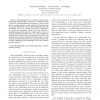Free Online Productivity Tools
i2Speak
i2Symbol
i2OCR
iTex2Img
iWeb2Print
iWeb2Shot
i2Type
iPdf2Split
iPdf2Merge
i2Bopomofo
i2Arabic
i2Style
i2Image
i2PDF
iLatex2Rtf
Sci2ools
WCRE
2009
IEEE
2009
IEEE
Static Detection of Disassembly Errors
—Static disassembly is a crucial first step in reverse engineering executable files, and there is a considerable body of work in reverse-engineering of binaries, as well as areas such as semantics-based security analysis, that assumes that the input executable has been correctly disassembled. However, disassembly errors, e.g., arising from binary obfuscations, can render this assumption invalid. This work describes a machine-learning-based approach, using decision trees, for statically identifying possible errors in a static disassembly; such potential errors may then be examined more closely, e.g., using dynamic analyses. Experimental results using a variety of input executables indicate that our approach performs well, correctly identifying most disassembly errors with relatively few false positives. Keywords-disassembly; reverse engineering; binary analysis; machine learning;
| Added | 21 May 2010 |
| Updated | 21 May 2010 |
| Type | Conference |
| Year | 2009 |
| Where | WCRE |
| Authors | Nithya Krishnamoorthy, Saumya K. Debray, Keith Fligg |
Comments (0)

